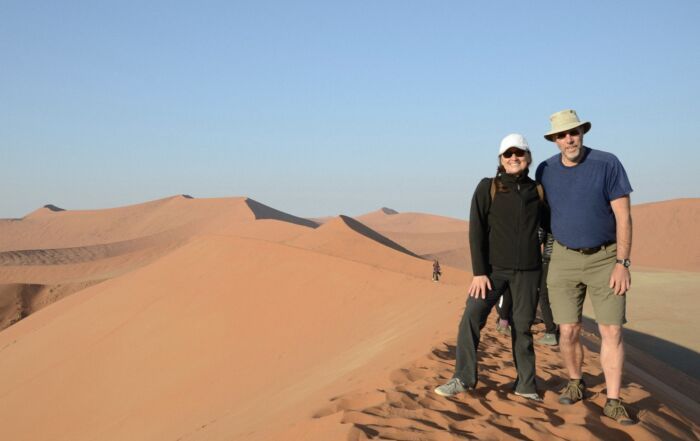Sossusvlei is one of those places that you have to see to believe. And even then, it’s hard to wrap your head around the sheer size and scale of this place. The sand dunes here are some of the tallest in the world, reaching over 300 meters in height in some cases. And the Sossusvlei salt pan is so vast that it feels like you could get lost in it for days. But what really makes this place special is its unique landscapes and natural history. UNESCO has recognized Sossusvlei as a World Heritage Site for its outstanding geological and ecological value. So if you’re looking for an amazing place to explore on your next vacation, be sure to add Sossusvlei to your list!

What is Sussusvlei and why was it designated as a UNESCO World Heritage Site?
Sossusvlei is a salt and clay pan located in the Namib Desert, near the resort town of Solitaire in southern Namibia. It is one of the most impressive sights in Africa, with towering red dunes reaching up to 400 meters in height surrounding it. The clay pan itself is actually an ancient dried-up lake bed, and the clay bottom reflects back a rich orange-red light that gives the area its unique character.
Sossusvlei’s remarkable landscape of sand dunes, dry riverbeds, salt pans, and rugged mountains were deemed worthy of UNESCO World Heritage status in 2013 because they provide an outstanding example of the evolutionary processes that have shaped landscapes over millions of years. This site provides evidence of how the Earth has changed from ancient times to the present day by showcasing an array of geological features including fossilized coral reefs, desert pavement, and conglomerate rock formations. It also offers a breathtaking visual representation of ongoing environmental changes such as shifting climate patterns, wind erosion, and water evaporation which continue to shape this arid ecosystem today.
Moreover, the Sossusvlei area is home to various rare and sensitive species. Its diverse habitats including desert scrub, wetlands, and grasslands offer refuge for various birds, reptiles, and other small mammals. The site’s significance extends beyond its natural beauty; it serves as an important cultural landscape for native people who have used this area for centuries as their primary source of food and sustenance.
Therefore, UNESCO felt that Sossusvlei merited special protection in order to preserve its astounding beauty, ecological value, and cultural heritage for future generations. The designation ensures that the site will be managed responsibly so that visitors can enjoy its unique environment without causing any harm or disruption to the local wildlife or ecosystems.
For these reasons, Sossusvlei is a truly unique and treasured place that will remain protected for many years.
What are some of the unique features of this area that make it so special?
Some of the unique features of Sossusvlei that make it so special include its towering red sand dunes, dry riverbeds, salt pans and rugged mountains. These geological features provide an outstanding example of evolutionary processes that have shaped landscapes over millions of years.
Additionally, the clay pan reflecting a vivid orange-red light gives the area an otherworldly beauty. The area’s diverse habitats are also home to various rare and sensitive species such as birds, reptiles, and small mammals which offer refuge from their surrounding hostile environment.
Finally, this site is culturally significant for native people who use it as a primary source of food and sustenance. All these elements combine to make Sossusvlei a truly unique place that is well worth preserving.
How can visitors best enjoy their experience at Sussusvlei?
Visitors to Sossusvlei can enjoy a range of activities such as sand boarding down the dunes, four-wheel driving through the desert, hot air ballooning over the pan and dunes, and bird watching in the area. Visitors can also take guided tours through the Dead Vlei – an ancient clay pan with dead camel thorn trees scattered across its surface – or explore Sesriem Canyon, one of Namibia’s oldest geological sites.
For those looking for a unique camping experience, there is also a designated campground near the site where visitors can set up their tents. Additionally, those seeking additional relaxation can take advantage of nearby lodges and safari camps to enjoy the stunning landscape from a comfortable distance.
Overall, Sossusvlei is an incredible destination that offers visitors a unique opportunity to explore some of Namibia’s most spectacular landscapes and experience its diverse wildlife and cultural heritage. With its UNESCO World Heritage status ensuring responsible management of the area, this site will remain protected for years to come.
What are some tips for people visiting Sossusvlei?
Some tips for people visiting Sossusvlei include:
- Wear appropriate clothing – be sure to bring sun protection including hats, sunglasses and sunscreen as well as warm layers depending on the time of year you are visiting.
- Bring plenty of water – as the area is very dry, make sure to bring enough water for the duration of your visit.
- Prepare for a long day – Sossusvlei is best explored during daylight hours, so plan accordingly and allow yourself enough time to take in all its beauty.
- Pack snacks – there are no shops within the reserve so it’s good to bring along some snacks to keep you going throughout your visit.
- Take special care when taking photos – If taking photos from any moving vehicle, try to use shutter speeds of 1/200th sec or above, and also be conscious of not blocking other visitors’ views.
- Respect the wildlife – be mindful when in the presence of wild animals and keep a safe distance from them at all times.
- Follow the rules – adhere to any applicable regulations, leaving no trace behind, and help preserve the area for future generations.
- Have fun – most importantly, enjoy your visit! Sossusvlei is an incredible natural landscape that deserves to be experienced and cherished by all who visit it.
What are some of the challenges facing this region and how can we help to preserve it for future generations?
The main challenges facing this region are related to climate change. The area is particularly vulnerable to the effects of global warming, and increased temperatures have been linked to decreased precipitation which has resulted in a decline in vegetation and wildlife species. In addition, overgrazing of the fragile environment by livestock has led to further damage, making it even more difficult for plants and animals to survive in the area.
To help preserve Sossusvlei for future generations, there needs to be an increase in awareness about how human activities can negatively impact the environment. This can involve educating people on the importance of sustainable tourism practices such as disposing of waste responsibly, avoiding off-roading and reducing water consumption. Additionally, measures should be taken to reduce the pressure of livestock grazing in the area and to promote more careful management of natural resources. Finally, it is important to support organizations that are working towards preserving Sossusvlei for future generations by contributing funds or volunteering time. Together, these efforts can help ensure that this unique and beautiful landscape will remain intact for years to come.

